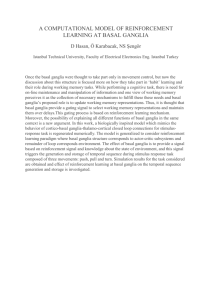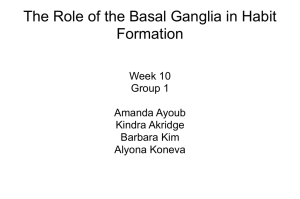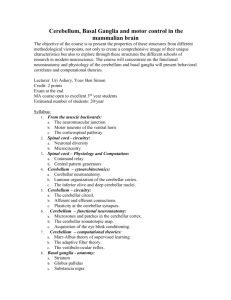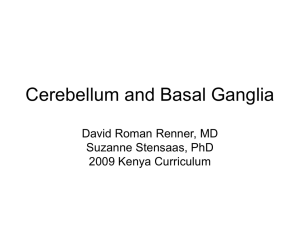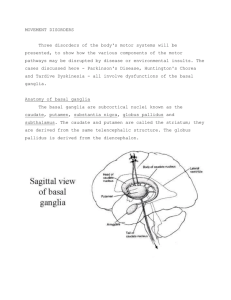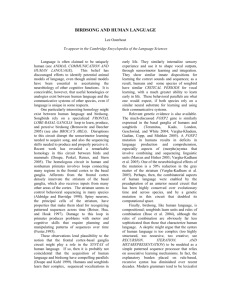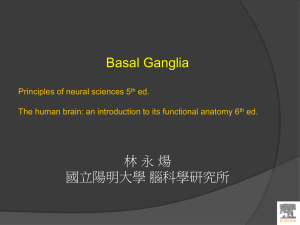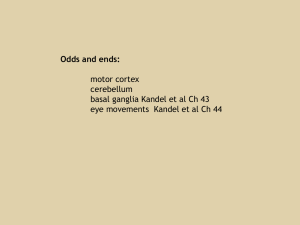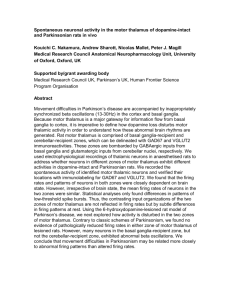zbasalganglia_part2
advertisement
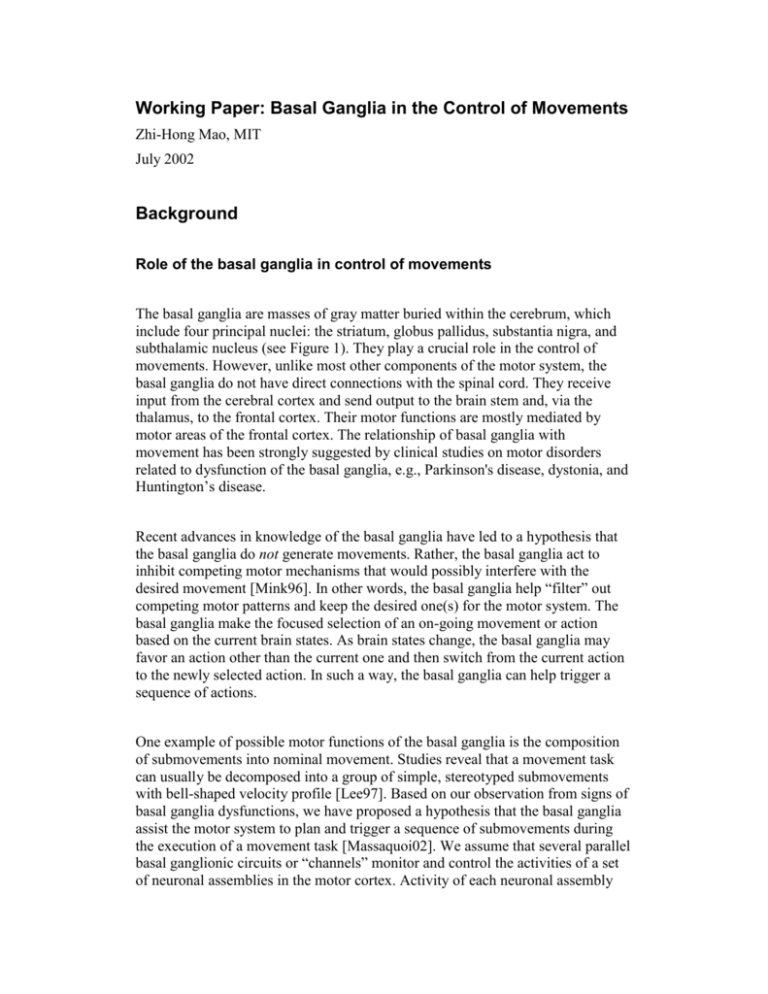
Working Paper: Basal Ganglia in the Control of Movements Zhi-Hong Mao, MIT July 2002 Background Role of the basal ganglia in control of movements The basal ganglia are masses of gray matter buried within the cerebrum, which include four principal nuclei: the striatum, globus pallidus, substantia nigra, and subthalamic nucleus (see Figure 1). They play a crucial role in the control of movements. However, unlike most other components of the motor system, the basal ganglia do not have direct connections with the spinal cord. They receive input from the cerebral cortex and send output to the brain stem and, via the thalamus, to the frontal cortex. Their motor functions are mostly mediated by motor areas of the frontal cortex. The relationship of basal ganglia with movement has been strongly suggested by clinical studies on motor disorders related to dysfunction of the basal ganglia, e.g., Parkinson's disease, dystonia, and Huntington’s disease. Recent advances in knowledge of the basal ganglia have led to a hypothesis that the basal ganglia do not generate movements. Rather, the basal ganglia act to inhibit competing motor mechanisms that would possibly interfere with the desired movement [Mink96]. In other words, the basal ganglia help “filter” out competing motor patterns and keep the desired one(s) for the motor system. The basal ganglia make the focused selection of an on-going movement or action based on the current brain states. As brain states change, the basal ganglia may favor an action other than the current one and then switch from the current action to the newly selected action. In such a way, the basal ganglia can help trigger a sequence of actions. One example of possible motor functions of the basal ganglia is the composition of submovements into nominal movement. Studies reveal that a movement task can usually be decomposed into a group of simple, stereotyped submovements with bell-shaped velocity profile [Lee97]. Based on our observation from signs of basal ganglia dysfunctions, we have proposed a hypothesis that the basal ganglia assist the motor system to plan and trigger a sequence of submovements during the execution of a movement task [Massaquoi02]. We assume that several parallel basal ganglionic circuits or “channels” monitor and control the activities of a set of neuronal assemblies in the motor cortex. Activity of each neuronal assembly triggers a basic action, e.g., a stereotyped simple submovement. Physiological movements are then achieved by rapidly switching activities among those neuronal assemblies, and the role of the basal ganglia is to organize appropriate transitions of cortical activities. Figure 1. Basal ganglia anatomy: (a) Internal pathways. GPe and GPi are external and internal segments of the globus pallidus, respectively; STN represents subthalamic nucleus; SNc and SNr are substantia nigra pars compacta and substantia nigra pars reticulata, respectively. (b) External pathways showing major inputs and outputs. This figure is adapted from [Gurney01]. Approach In this phase of research, we will explore the following two ideas borrowed from the research of motor control and basal ganglia to the study of vehicle control. Modular composition and decomposition The decomposition of a complex task into simpler subtasks is a general strategy for motor control. We have shown previously how a nominal movement is achieved by accurate composition of a set of submovements and what the basal ganglia contribute to the composition of submovements during the movement. This may bring us some insight into the vehicle control strategies. For example, given a path planning task and a set of basic maneuvers of a vehicle, how do we “efficiently” or “optimally” realize the task for the vehicle from some combination of the maneuvers? For this problem, we may be able to learn something useful from the organization of submovements by the basal ganglia. Modular composition and decomposition can also be found in group behaviors. Useful, complex group behavior is usually based on a combination of relatively simple reactions. These reactions exist within a collection of nominally autonomous agents. We assume that the physiological basis for general behavioral reactions is the same as that for the reactions (submovements) used for body movement control and postural regulation, and the triggering of elemental behavioral reactions depends significantly on the function of the basal ganglia. Therefore, an accurate model of the function of the basal ganglia should provide important insight into the control of group behavior. This would also possibly bring ideas into the cooperative control involving multiple vehicles. Adaptation and repair strategies Being able to adapt to new or varied environments and able to recover wholly or partly from damage are always amazing properties of motor systems. Clinical studies show that slowly growing brain lesions do not necessarily betray their presence by early signs of dysfunction, because the brain learns to adapt and to compensate for them in movements and postures [Brooks86]. It is the suddenly inflicted lesion like a stroke that can produce immediate and obvious consequences. However, even for sudden and relatively severe damages of brain, patients can sometimes regain to some extent their motor skills through training. The abilities for the motor systems to adapt and to repair are due to (1) the plasticity of neuronal connections, i.e., the ability to learn, and (2) redundancy in number of neuronal modules and connections. A deep understanding of these properties of motor systems would probably be very helpful to the control and design of safe vehicle systems. In our current phase of research, we are trying to understand the learning mechanisms of the basal ganglia. It is now widely accepted that different neural circuits are specialized for different types of learning. The basal ganglia have been proposed as structures critical for reward-based learning [Aosaki94]. However, till now there is no consensus on the learning circuitry and neuronal synaptic plasticity in the basal ganglia. We try to build in our model a reasonable representation of the learning circuits and learning rules of the basal ganglia, taking into account the cellular and molecular basis of longer term potentiation and depression. We also hope to gain insight into some of the adaptation and optimization problems of vehicle control, based on a study of biological version of the reinforcement learning (by the basal ganglia). References [Aosaki94] Aosaki, T., Graybiel, A. M., & Kimura, M. Effects of the nigrostriatal dopamine system on acquired neural responses in the striatum of behaving monkeys. Science 265, 412-415 (1994). [Brooks86] Brooks, V. B. The Neural Basis of Motor Control (Oxford University Press, 1986). [DeLong00] Delong, M. R. The basal ganglia. In Principles of Neural Science (eds Kandel, E. R., Schwartz, J. H. & Jessell, T. M.) 853-867 (McGraw-Hill, 2000). [Gurney01] Gurney, K., Prescott, T. J. & Redgrave P. A computation model of action selection in the basal ganglia (I): a new functional anatomy. Biological Cybernetics 84, 401-410 (2001). [Lee97] Lee, D., Port, N. L. & Georgopoulos, A. P. Manual interception of moving targets: II. On-line control of overlapping submovements. Experimental Brain Research 116, 421-433 (1997). [Massaquoi02] Massaquoi, S. G., Mao, Z. -H., Lim, E. J., Dahleh, M. & Feron, E. A preliminary model for the role of the basal ganglia in natural motor control and motor programming. In Meeting for Multidisciplinary Research Program of the University Research Initiative, Salem, MA, June 2002. [Mink96] Mink, J. W. The basal ganglia: focused selection and inhibition of competing motor programs. Progress in Neurobiology 50, 381-425 (1996).
